Abstract
The current article presents research on the likelihood that the individual approach in pedagogical practice leads to discrimination practices toward students. Teachers have long been considered as leading figures in Bulgarian society throughout the history and have been actively participating in shaping the nation. With the contemporary changes in teachers’ role, educational tasks and newly formed skills and requirements in the personal development for each student and the ever changing expectations from society toward teachers’ abilities and social and emotional competences, it becomes clear that teachers often relay on their personal attitudes toward a student or a group of students to guide them when evaluating or even giving tasks with a different level of difficulties in order to help them improve which could easily be mistaken as an individual approach. The presented research aims at collecting data from in-service teachers in order to provide further information on the status of use/misuse of individual approach within Bulgarian educational system. The authors do not in any way imply that the teachers are intentionally agreeing to discrimination against one student or a group of students. On the contrary, the article presents the attitudes toward individual approach as a common practice which is used often but also being misused with good intentions. The target group consists of 86 in-service teachers selected randomly from different regions of Bulgaria, teaching in different types of schools and kindergartens. The article presents the outcomes and some applicable recommendations for preventions of discriminatory practices as a result from application of individual approach in education.
Keywords: Individual approachdiscriminationkindergartenschool
Introduction
In 2003 Bulgaria approved Protection Against Discrimination Act (PADA). The PADA was first implemented on January 1st 2004 as an answer to Bulgaria’s commitment to the international legislature and directives for protection against all forms of discriminations and for prevention of discrimination. The specialized body which oversees the implementation process is done by the Commission on the protection against discrimination.
Article 4 in three of its paragraphs highlights the signs of discrimination and when it is direct or indirect discrimination. People could be discriminated on the basis of gender, race, nationality, ethnicity, citizenship, human genome, origin, religion or faith, education, beliefs, political affiliation, sexual orientation, family status, property status or any other characteristics established by law or by international contract to which the Republic of Bulgaria is a side (Protection Against Discrimination Act (PADA), 2004, art.4, paragraph 1).
Protection Against Discrimination Act (PADA) (2004) also outlines the cases which are not considered discrimination according to the indicators which are covered; section two outlines protection of the right to education.
A quick analysis of the Commission’s public decisions shows that the anti-discrimination proceedings filed in the educational sector are concerning issues related to verifying compliance with legal requirements in the application process for first-grade admission criteria, discriminating ethnicity or special educational needs (http://www.kzd-nondiscrimination.com/layout/index.php/publi4en-registyr).
As Borisova (2006) points out, one of the challenges teachers are facing in the age of globalization is the difficulty of adapting to the new educational realities (p. 5). The teacher’s responsibilities are expanded and quite often they have to look for most direct way to influence students’ personal growth and development and to ensure and foster their appropriate preparation for the future.
According to Moskovichi (2006), “preliminary judgments can foster the rise of discriminatory actions” (p. 569). And since the individual approach does not appear as a separate indicator (of course, it can be implied), the authors are motivated to present this study.
The Bulgarian Psychological Society (BPS) has been a constant promoter for changes in practices in education that lead to discrimination. In an official statement published on their official site on 08.09.2012 they provided a structured outline of the most warning practices in schools and why the matter should be taken seriously. Studies conducted within the Program for employment and social innovation PROGRESS (2007-2013) showed that almost one fourth of Bulgarians share that they believe children with different origin should attend different schools; 20% of teachers also believe that children with different origin have different abilities. Such data in itself provides the preexisting conditions in teachers’ attitudes for discriminatory practices. The borderline between beliefs and acting upon ones’ beliefs then quickly diminishes leading to actions which are discriminating in the way teachers teach, model behavior and the school itself becomes a contributing factor (not acting upon preventing such practices).
Another research cited by the BSP is the Access to educational and ethnic discrimination, 2006 which was conducted upon the request of the Commission against discrimination. The research looked at discriminatory practices in educational settings in the context of a close correlation between economic status and access to education. The sample included parents from different minority groups and representatives from all groups agreed that they have experienced discrimination based on ethnic origin (varying from 10 % for Bulgarians, and Turkish to 16 % for Roma minorities). The practice of different attitude of teachers toward children based on their ethnic origin is not overwhelming but quite visible and disturbing. They judge students based on their language abilities (native and others), possession and use of computer, access to internet, being able to afford private lessons, acceptance rate in elite high schools. The outcomes showed that not only expectations of parents for their children being able to graduate and continue their education varied considerably, but the attitudes of teachers followed closely along the same line.
Problem Statement
The individual approach’s potential in pedagogical practice to produce discrimination against students has presented itself as an issue which is the basis of the current research. The influence of teacher’s attitudes and expectations toward students was first published by Rosenthal and Jacobson in 1968 in their classic experiment described in the “Pygmalion Phenomenon”. They conducted a study in an elementary school, where they randomly selected 20% of pupils and told teachers that they have a high potential to succeed and reach a higher intellectual outcomes; they informed the teachers that other 80% were considered “average”. The results showed that the teachers then reported indeed a higher level of achievements in the group of 20%. In a sense this has turned into a self-fulfilling prophecy. The conclusion Rosenthal and Jacobson have made was that “Teachers possess different expectations of students in class. The nature of the expectations of a particular student’s success often leads to self-fulfilling prophecies, they claim. ... teachers may view students differently due to their own expectations of the students’ physical fitness..” (Lagestad, Lyngstad, Bjerke, & Ropo, 2019, p. 1).
Labeling theory first originated within the sociological approach to deviant behavior where the theory explained the effects of social labeling in development of deviant behavior. The French sociologist Durkheim (2005) first introduced the idea in his monograph Suicide in 1897, where he proposed that the labeling as “deviant” is a mean to achieving the need for behavior control. When using labels, one defines a person or a group of people in a highly simplified manner – excluding different aspects that define them and providing a very simplified version. It is often based on the impression a person creates at their first glance: they are either “I am interested and will make the effort to get to know you” or “I have no interest in putting any more efforts in getting to know anything about you” and last but not least “I do not wish to get to know you, in fact I will avoid you”.
Later, Mead (1934) further developed the idea and suggested that interaction between people and with the group/community helps socially construct the self and it is within that interaction that people create labels for others based on their own views of the behaviour, appearance and attitudes.
Applied to schools labelling theory would provide the means for teachers to define each student by judging them based on their behaviour, temper, previous records, and even interaction with their parents/caregivers. The problem with labelling comes when teachers use their own personal judgment as the measuring level for labelling and by doing so rigidly set limitations to what a student can or cannot do.
A lot of the early, classic studies on labelling focused on how teachers label according to indicators of social class background, not the actual ability of students.
In 1970, Rist went on to research the effect on labelling in kindergartens in North America and presenting labelling as being highly influenced by social status. Rist’s (1970) research showed that in many cases teachers had made their mind about children’s abilities based on little or no evidence of the ability but rather using appearance, cleanness, what kind of education their parents have as well the economic status of their families.
Research Questions
The research question for the current research and publication is concerning Bulgarian teachers’ use of the individual approach as a means to help personal growth and development or is it misused as a way of segregating children in accordance with the teacher’s attitudes toward children.
Purpose of the Study
The purpose of the study is look into the teachers’ attitudes and assumptions in order to analyze wheatear teachers’ perceptions of the individual approach are tied to differentiating the difficulty of pedagogical tasks according to the abilities of students, which may be a prerequisite for hidden/indirect discrimination.
Research Methods
The information was gathered via a questionnaire. In total, it includes 7 questions. Four of them require a choice between provided alternative answers. Two have a ranking requirement, and one is open-ended. Items can be differentiated into two areas:
Related to the attitudes and understanding of teachers on the individual approach to education;
Oriented towards teachers’ social attitude towards certain groups of students as a prerequisite for discrimination.
The study includes 86 randomly selected teachers. The sample includes teachers from different regions, different types of schools and kindergartens.
Findings
Item No. 7 “What do you think is an “individual approach” in pedagogy?” is the only open-ended question. It is the last one in the questionnaire, but it is key to verifying the working hypothesis. Respondents’ answers are divided into two groups according to the content they use in the individual approach (Figure
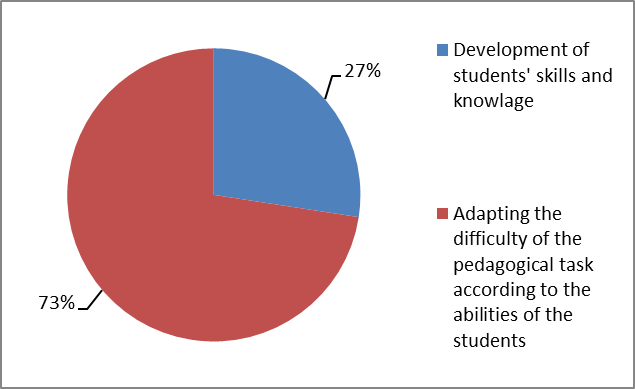
It becomes clear from the results that undoubtedly the majority of teachers are willing to give assignments with varying degrees of difficulty to their students. Such pedagogical behavior can also be perceived as a direct assessment of students’ abilities without applying objective criteria. In this case, it is a prognostic assessment, i.e. assessing not the real achievements of students, but on the assumption of their skills and abilities (how would they be able to handle a certain task). The question concerning the frequency of such events at school is quite logical.
Question 3 requires teachers to determine how often they give students tasks with varying degrees of difficulty in accordance to their own assumption and assessment of students’ abilities. It is important to note that the issue includes the notion of “abilities”, not skills or knowledge, as well as the teachers’ subjective assessment of these abilities. The obtained outcomes are summarized in Figure
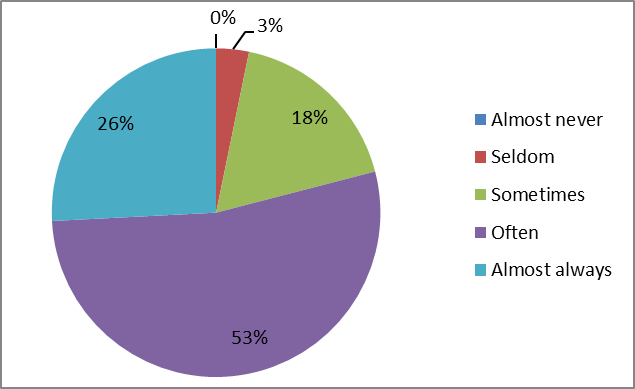
The results show that even teachers who perceive an individual approach to education as a student support in reality are inclined to apply the opposite concept - a subjective prognostic assessment of students’ abilities and matching the task to them. Moreover, such practice appears to be widespread to be considered as very useful practice in pre-school and school education in Bulgaria. Since only 3% of respondents “rarely” use an individual approach, one cannot ignore the motivation of the other 97% who apply it “sometimes”, “often” and “almost always”.
Question 2 aims to measure teachers’ assessment of the effectiveness of applying such an approach to working with students (Figure
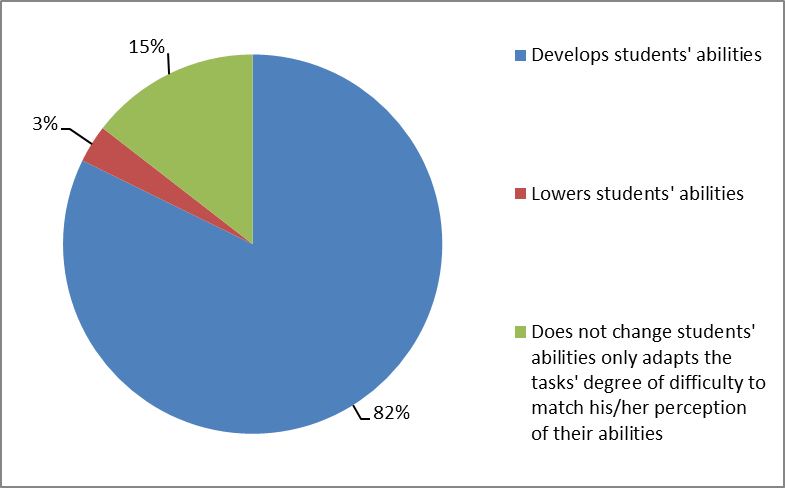
It is immediately noticed that a significant proportion of teachers (82%) believe that by adapting the tasks according to the abilities of their students they can develop the same abilities. It is this view that can be considered as a main motivation for the massive application of the individual approach in Bulgarian education. One should not overlook the 18% group that assesses the individual approach as ineffective in developing students’ abilities.
In order to verify the second part of the working hypothesis - that the individual approach can become a prerequisite for discrimination, three items are added to the questionnaire where respondents are asked to rate certain groups of students. Question # 4 requires them to select 3 out of a total of 13 groups of students, having to score 1, 2 or 3 for each of them. A score of 1 indicates that those students are most capable according to the interviewed teachers, 2 is less capable and 3 – the least capable. In order to make the results clearer and more comprehensible, pre-calculations were performed during their processing.
Each score of 1 received weight 3, score 2 - 2, and score 3 - weight 1. After recalculation, groups of students placed in the first position received the highest number of points and vice versa. The results are presented in Figure
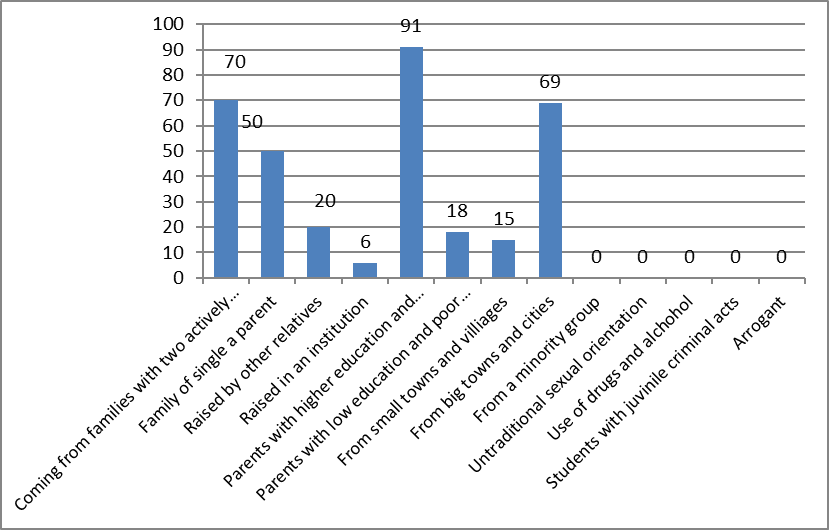
The results directly reflect teachers’ attitudes to certain groups of students. The propensity of teachers in making assumptions about students’ abilities on the basis of indirect or relevant criteria is quite obvious. From the results obtained, a profile of the “most capable” student type can also be displayed. The “most capable” student comes from a family with two parents, who raise the children together. The parents are highly educated and have a high status in society. At the same time they come from a big city. Of course, such an assertion cannot be inferred from this study. In their answers to this question, teachers express their social attitudes towards whole groups of society. And students belonging to these groups “inherit” the characteristics of the groups. In social sciences, this phenomenon is known as dispositional attribution and is associated with social attitudes of the type of prejudice or stereotype (Jonkova, 2017).
A total of 13 groups of students are included in the questionnaire, but Figure
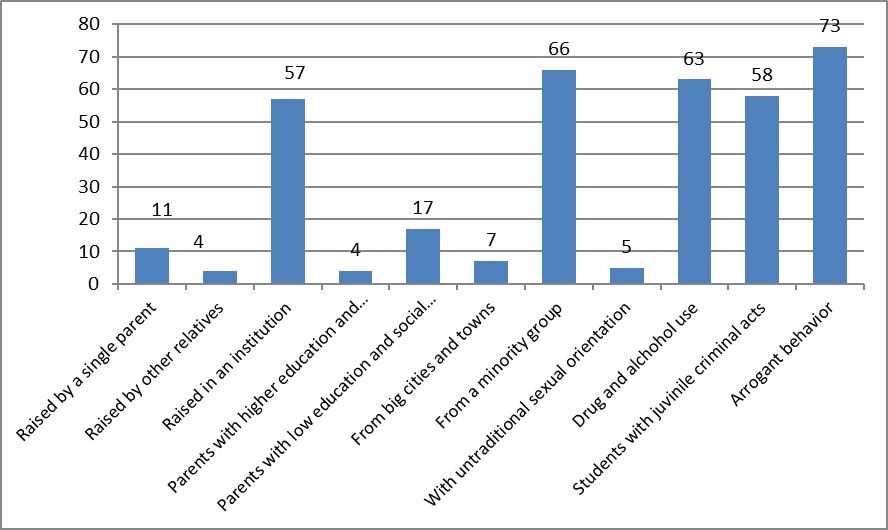
It is worth noting that when asking the negative alternative to the question of students’ abilities, the distraction of answers is much greater. Such a result can be interpreted through the prism of dominant negative social attitudes towards a wide range of groups in society. However, it is clearly outlined the tendency for certain students to be perceived as less able than others. The first category includes students with arrogant behavior that systematically disrupt order and discipline at school; followed closely by the students with minority background and those who use alcohol or narcotics. Similarly, students who have been raised in social institutions or community services received such an assessment as well.
In view of the fact that no confidence interval and standard deviation were calculated, as well as the small differences between individual estimates, the statistical significance of the differences in the values obtained cannot be inferred. However, data suggest that respondents define these groups as “least able”. In other words, teachers have a negative social attitude towards students belonging to the groups listed and consider them less able than those belonging to the groups identified in Figure
Following his / her own attitudes towards particular groups, a teacher could ignore the individual abilities of a student unconsciously. The natural consequence of such process would be to underestimate or overstate the students’ abilities. Hence the attempt to adapt the degree of difficulty of the pedagogical task to the students’ abilities becomes impossible. Pedagogical behavior based on social attitudes (especially if they are of the type of prejudice or stereotype) does not just decrease the levels of students’ motivation toward pedagogical tasks, but can also lead to regression in the development of their abilities.
When examining the tendency towards discrimination and social attitudes towards particular groups, it is also appropriate to assess the tolerance of respondents. This is the purpose of question 6 of the questionnaire. It requires respondents to indicate groups of students for whom they are willing to compromise in the evaluation process. There is no requirement for rankings or limitations in the number of selections, and the groups from which respondents can choose are the same as in questions 4 and 5. The results are presented in Figure
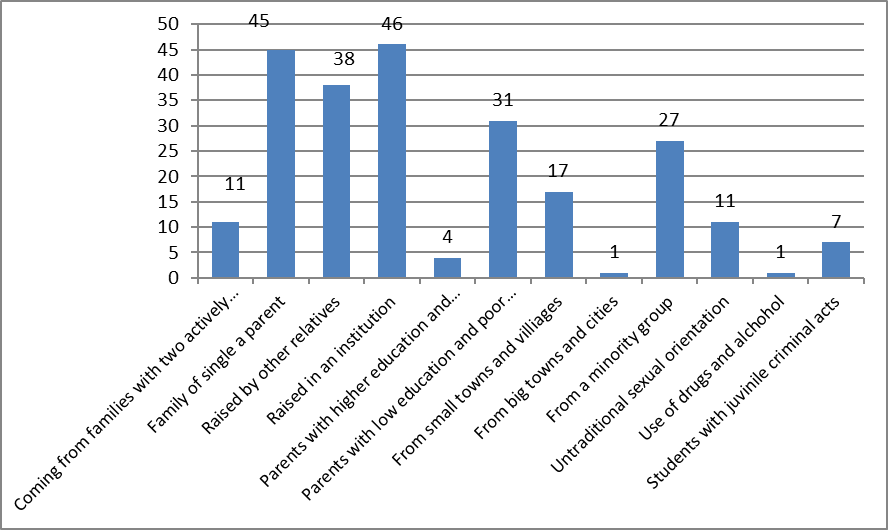
These groups of students can be divided into 3 categories: enjoying high tolerance on behalf of teachers’ evaluation (results from 46 to 31 pts); such as those with moderate tolerance (between 30 and 15 points) and students with low tolerance (less than 15 points).
The first group includes the so-called tolerated students:
Students in social institutions and services;
Students raised by one parent;
Students raised by relatives who are not their parents;
Students raised by parents with low educational and social status.
The second category includes students being moderately tolerated:
Students from minorities;
Students from small towns and villages.
Teachers are least tolerant toward the third group of students:
Two-parents present in the family;
Students with unconventional sexual orientation;
Students with registered antisocial behavior;
Students whose parents have a high educational and social status;
Students from large settlements;
Students using alcohol or narcotics.
Even without a deeper analysis of the individual groups in quantitative or qualitative terms, it can be concluded that there are serious preconditions for discrimination. The very fact that teachers tend to compromise to varying degrees in assessing the skills and abilities of students from different social groups means that there is discrimination that is inherent in the pedagogical process based on the individual approach.
Conclusion
Based on the outcomes several conclusions could be drawn:
The individual approach to education is perceived by a large number of teachers as the process of adapting the difficulty of the pedagogical task to the individual abilities of students;
Teachers’ social attitudes toward certain social groups have a significant influence on the assessment of those students’ abilities;
Researchers are inclined to exhibit subjectivism in assessing the abilities of their students by tolerating certain social groups and by harming others.
The individual approach to education far exceeds the adaptation of the difficulty of a task to the students’ abilities. This study does not seek to compromise this paradigm. On the contrary, it is aimed at identifying an applied aspect that could prove to be of a great importance for promoting the individual approach in school as a good practice.
The article poses many more questions than answers. It considers discrimination in the context of an individual approach but does not affect a number of other issues related to it. It would be interesting to study the link between school discrimination and growing school aggression. Efforts can also be made to diagnose the consequences of applying the individual approach to group class dynamics or the internal distribution of power among students.
References
- Borisova, Т. (2006). About interactivity in education in the subject of literature 1st-4th grade. Bulgaria: Кontrast.
- Durkheim, E. (2005). Suicide: A study in sociology. London: Routledge.
- Jonkova, К. (2017). The debate between human behavior models. Turnovo: Veliko.
- Lagestad, P., Lyngstad, I., Bjerke, Ø., & Ropo, E. (2019). High School students’ experiences of being ‘seen’by their physical education teachers. Sport, Education and Society, 1-12.
- Mead, G. H. (1934). Mind, Self, and Society. Chicago, MI: University of Chicago Press.
- Moskovichi, S. (2006). Nauka o massah. Psihologiya mass [Science about crowds. Psychology of crowds]. Samara: Hrestomatiya.
- PROGRESS. (2007-2013). Report “Stereotypes and prejudice in the textbooks, educational materials and curriculum in the pre-school and elementary school”. European Commission Program for employment and social innovation. Retrieved from http://www.sep.gov.mk/en/content/?id=205#.XOOam1IzaUk
- Protection Against Discrimination Act (PADA). (2004). State Newspaper, 7. Retrieved from https://www.legislationline.org/documents/id/20676
- Rist, R. (1970). Student Social Class and Teacher Expectations: The Self-Fulfilling Prophecy in Ghetto Education. Harvard Educational Review, 40(3), 411-451.
- Rosenthal, R., & Jacobson, L. (1968). Pygmalion in the classroom. The urban review, 3(1), 16-20.
Copyright information

This work is licensed under a Creative Commons Attribution-NonCommercial-NoDerivatives 4.0 International License.
About this article
Publication Date
23 January 2020
Article Doi
eBook ISBN
978-1-80296-077-8
Publisher
European Publisher
Volume
78
Print ISBN (optional)
-
Edition Number
1st Edition
Pages
1-838
Subjects
Teacher, teacher training, teaching skills, teaching techniques
Cite this article as:
Donev*, D., Ilieva, M., Uzunova, V., & Todorova, V. (2020). The Risks Of Discrimination In Applying Individual Approach In Kindergarten And School. In R. Valeeva (Ed.), Teacher Education- IFTE 2019, vol 78. European Proceedings of Social and Behavioural Sciences (pp. 269-278). European Publisher. https://doi.org/10.15405/epsbs.2020.01.33
